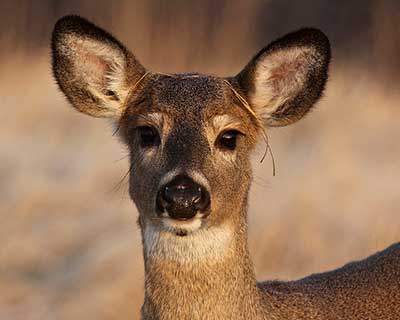Deer
By Rick Horton, National Wild Turkey Federation
The white-tailed deer is a “generalist” species, meaning it can survive in various types of habitats. However, one critical habitat requirement is “edge.” Optimal deer habitat is a balance of wooded and open habitats, maximizing edge.

Habitat needs
Forests provide deer with shelter from the weather, cover to escape predators, travel corridors, and food. Oak forests, for example, supply “hard mast” high in fats (e.g., acorns), essential for winter fat reserves. Cherry and apple trees can provide soft mast (e.g., fruits and berries) that are high in carbohydrates. Deer also browse buds, twigs, and leaves in the forest.
Open areas are also a crucial component of deer habitat, providing high plant diversity and therefore abundant browse and soft mast foods. In southern and central Wisconsin, deer feed heavily in corn and soybean fields. Other open areas used by deer include pastures, clear cuts, utility lines, railroad tracks, edges of ponds, brush lots, logging roads, and log landings.
The successional stage of these open areas is related to their use. The first 1 to 3 years after a clear cut provide excellent food resources for deer. Herbaceous plants are then shaded out as clear cuts age and the canopy closes. Regenerating stands at their rotation age makes forage accessible to deer again.
In winter, deer mainly browse woody plants, like northern white cedar, red maple, mountain ash, dogwoods, and aspen. A diversity of local plant communities will provide deer with food throughout the seasons and meet all their cover needs (see below).
Cover
One of the most important functions of forest cover for deer in Wisconsin – especially northern Wisconsin – is thermal protection in winter. Wooded areas block the wind, reduce radiant heat loss, and collect less snow, allowing deer to remain agile and better avoid predators.
Some trees that offer thermal cover are black spruce, white cedar, red cedar, and jack pine. These trees also supply emergency winter browse for deer. Forests, linear strips of woods, and thick brushlands can also offer deer travel corridors, cover from predators, and shade in the hot summer months. Brushy areas likewise help conceal newborn fawns.
Recommendations for attracting more deer
- Maintain open areas and plant diversity within these openings, especially in heavily forested areas. Forested stands should be placed in rotation so that cleared areas with diverse plant communities are widely distributed on the landscape. Maintaining patches of woods at many stages of succession will increase edge habitat and meet all the deer herd’s annual food and shelter requirements. At least 5% of the range should be in permanent openings about 3 acres in size.
- Encourage linear woods and the creation of cover in agriculturally dominated landscapes to provide protection from the weather, escape cover from predators, and travel corridors.
- In northern forests, preserve dense lowland stands of conifers for winter shelter in areas where such cover is scarce. Maintain a 50-foot wide area of young trees or shrubs adjacent to the cover so deer don’t have to travel far for winter food.
- Examine each property to determine its deficiencies. If a site is mostly forested, work on creating forest openings (clear cuts, food plots, etc.). If the site is in southern Wisconsin and dominated by agriculture, work on creating forests and linear woody cover.
